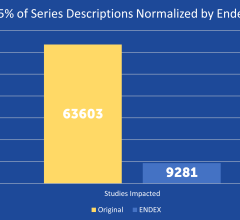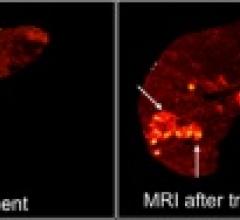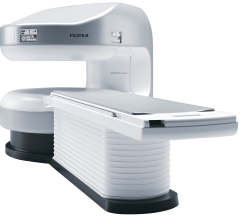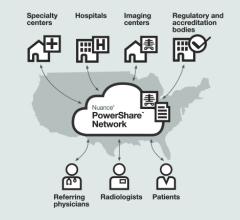May 2, 2014 — The University Medical Center (UMC) Utrecht and Quirem Medical, both in the Netherlands, announced they will be working closely together to maximize the benefits of using holmium microspheres to treat liver cancer patients worldwide. The unique properties of holmium microspheres will enable effective treatment planning and dosimetry in treatment evaluation, thereby further improving the results of patients who undergo radioembolization.
Anxiety regarding inconclusive test results is real and is only natural. Experts in breast imaging (researchers and clinicians) continue to work to reduce the number of false-positive exams that patients experience and ensure that follow-up exams are as minimally invasive as possible.
The American Society of Echocardiography (ASE) exhibited at the American College of Physicians’ (ACP) Internal Medicine 2014 meeting in early April as part of the society’s efforts to spread the word about the appropriate use of cardiac imaging tests.
Fujifilm’s APERTO Lucent is a 0.4T mid-field, open MRI system addressing today’s capability and image quality needs ...
May 2, 2014 — A new study has found that children and adolescents with attention deficit hyperactivity disorder (ADHD) have disrupted connections between different areas of the brain that are evident on resting-state functional magnetic resonance imaging (rfMRI). The results of this research are published online in the journal Radiology.
May 1, 2014 — Government regulations and JCAHO (Joint Commission) certification are driving providers to make purchasing plans for dose monitoring solutions, and in discussions about these plans, two vendors are capturing the majority of providers' mindshare. This is according to the latest KLAS report, Radiology Dose Monitoring Solutions 2014: Provider Strategies in an Evolving Market.

SPONSORED CONTENT — Fujifilm’s latest CT technology brings exceptional image quality to a compact and user- and patient ...
May 1, 2014 — Nuance Communications announced the immediate availability of the Nuance PowerShare network, the industry’s largest cloud-based network for securely connecting healthcare professionals to share essential medical images and reports as simply as people exchange information using social networks. The PowerShare network promotes fully informed and connected physicians and patients who instantly view, share and collaborate while addressing patients’ healthcare needs.
SPONSORED CONTENT — Fujifilm’s latest CT technology brings exceptional image quality to a compact and user- and patient ...
May 1, 2014 — Neurosurgeons at UC San Diego Heath System have, for the first time, combined real-time magnetic resonance imaging (MRI) technology with novel noninvasive cellular mapping techniques to develop a new biopsy approach that increases the accuracy of diagnosis for patients with brain cancer.
Carestream will be a panel participant in a session on “Problems and Solutions in Breast Tomosynthesis (DBT)” to be held during the 2014 meeting of SIIM (Society for Imaging Informatics in Medicine). The discussion will be moderated by Matthew B. Morgan, M.D., University of Utah Health Sciences Center. It will take place on Thursday, May 15, from noon - 1 p.m. in the Innovation Theater of Exhibit Hall B at the Long Beach Convention Center.
The radiation to me was negligible. Most of the high-energy photons emitted by the technetium my mother had swallowed were being absorbed. Enough registered on the detector for a diagnostic image, but a Geiger counter held next to Mom registered the equivalent of about one hundredth milliSievert (mSv). At seven feet away, I was plenty safe.
SPONSORED CONTENT — EnsightTM 2.0 is the newest version of Enlitic’s data standardization software framework. Ensight is ...
A successful dose management program faces a number of hurdles.
Imaging is critical to all medical specialties so it is logical that images should be available to specialists outside of radiology. There is a trend to reduce repeat exams by making images more easily accessible, including prior exams. This traditionally has been accomplished using the cumbersome process of mailing or physically carrying CDs to referring physicians. Often these CDs do not open or take a long time to download. Stage 2 Meaningful Use requirements for certified electronic medical records (EMR) also call for the sharing of medical images electronically to help improve efficiency and reduce healthcare costs. All of these factors have given rise to remote image access systems.
UnityPoint Health, formerly Iowa Healthcare, a multi-city integrated delivery system based in Des Moines, Iowa, recently consolidated and standardized technology in a transformation aimed at empowering primary care physicians to take the lead in care coordination for patients. Todd Holling, assistant director of clinical applications for UnityPoint Health, explains what they are trying to achieve and how healthcare IT is helping them reach their goals.
Did you know that approximately one-third of all the data in world is created by the healthcare industry and that ...
Congress recently passed the Protecting Access to Medicare Act of 2014 (H.R. 4302) that delays a 24 percent Medicare physician payment cut for 12 months. The legislation also requires use of appropriate use criteria (AUC) and clinical decision support (CDS) software to get Medicare reimbursement, which will likely shift focus onto IT vendors who can supply this software. In addition, the use of CDS is part of Stage 2 Meaningful Use requirements for electronic medical records (EMR), so the new Medicare requirements will move CDS up on many IT departments’ priority lists.
Proton therapy is becoming more prevalent in cancer treatment as it is the most advanced form of radiation available. Proton beams are more precise, treating complex tumors while avoiding healthy tissues and critical structures. Proton therapy centers are beginning to spring up around the United States as physicians continue to see the benefits in cancer treatment. One center that has garnered much attention is the CDH Proton Center in Warrenville, Ill.

SPONSORED CONTENT — EnsightTM 2.0 is the newest version of Enlitic’s data standardization software framework. Ensight is ...
Since entering the market in 2001, PET/CT (positron emission tomography/computed tomography) has come a long way in combining the benefits of individual PET and CT imaging. Last year saw the release of several new innovative technologies, marking improvements on previous generations of PET/CT, such as continuous data acquisition and bed motion, as well as higher image resolutions.
The use of magnetic resonance imaging (MRI) is growing both domestically and internationally, rebounding from the slump that hit the market in 2008-2009. Vendors have seen an increase in system utilization. According to Stuart Clarkson, senior director of the MR business unit at Siemens Healthcare, “We’ve seen approximately 3 to 4 percent growth in the number of scans this year versus the previous year. So, we like to think that MR is still a growing imaging modality.”
ECRI Institute healthcare market researchers said manufacturers developed intraoperative magnetic resonance imaging (iMRI) technology to improve conventional image-guided neurosurgery techniques that rely on preoperative patient scans for guidance during the procedure.
A new technique that brings computed tomography (CT) imaging into the operating room will allow surgeons to precisely demarcate and remove small sub-centimeter lung nodules, leaving as much healthy tissue as possible, according to Raphael Bueno, M.D., of Brigham and Women's Hospital in Boston.
Founded nearly 25 years ago and based in Cincinnati, ProScan Imaging is one of the largest privately held teleradiology companies in the world. ProScan provides teleradiology services for more than 300 locations across North America and around the globe. In addition, the company owns and operates 26 outpatient imaging centers in seven states, and WorldCare Clinical, which collects and assesses medical images in support of clinical research trials.
According to the European CanCer Organisation (ECCO), there are more than 1.6 million new cases of breast cancer diagnosed globally each year. This number has been increasing at a rate of 3.1 percent per year. As Prof. Peter Boyle, director of the University of Strathclyde Institute of Global Public Health at the International Prevention Research Institute (iPRI) in Lyon, France, told conference-goers at the European Breast Cancer Conference (EBCC-9), “We need to make a reduction in the number of women developing and dying from breast cancer a global priority.”


 May 02, 2014
May 02, 2014 













